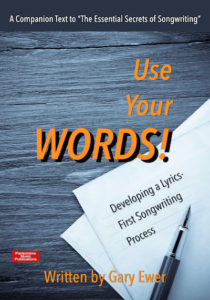When I’m writing original music — which is to say, composing, not arranging someone else’s tune — I practically always do some kind of melody-first method.
 When you hear a problem with your song, but don’t know how to solve it, you might find the answer in “Fix Your Songwriting Problems – NOW!” Get this eBook separately, or as part of “The Essential Secrets of Songwriting 10-eBook Bundle”
When you hear a problem with your song, but don’t know how to solve it, you might find the answer in “Fix Your Songwriting Problems – NOW!” Get this eBook separately, or as part of “The Essential Secrets of Songwriting 10-eBook Bundle”
The reason I always opt for creating a melody as a first step is this: if I create a melody, I find adding chords to be an easy step. The other way — getting a chord progression and then finding a compelling melody — is a method I find to be a lot harder.
I like having the melody first because I can use the chord progression stage to help craft the mood of the melody. If I want that melody to have a kind of melancholy feel, for example, I opt for lots of minor chords, and probably go for descending bass lines, etc.
It also allows me to come up with more interesting chord progressions more easily. Having the chords first makes me feel a bit “locked in” and improvisation is a bit more difficult for me.
Some writers fear that trying to come up with a melody when you don’t have the chords means your tune will have a kind of randomness, but I almost never feel that way. When I improvise on melodies, I find that my musical brain keeps things organized. I may not know where the melody is going to end up, but that doesn’t at all mean that I’m just going to create garbage.
If you’re interested in experimenting with a melody-first method, try this:
- Grab your guitar or other chording instrument.
- Strum a chord and sing the first note that comes to mind.
- Now sing a pattern of notes, maybe five to ten different pitches. (You’ll be pleased to notice that they’ll probably make some sort of musical sense!)
- Don’t worry about chords yet… Just try repeating (either exactly or approximately) that cell of notes,
- Keep going! With each little bit you create, ask yourself: if I heard this bit of melody on a recording, what might follow it?
- As you proceed, hold off creating chords for as long as possible. Be aware of where your melody is moving. Is it starting low and moving high? Is it made up of short repeating ideas, or do new ideas keep spinning out?
You’ve likely spent a good portion of your time as a songwriter thinking of melody as something that gets added to a chord progression. So this may feel strange, and may take you out of your comfort zone.
But that’s the great part about this process; if you want to become more creative, you really must move beyond your comfort zone and do something you’ve rarely done before.
Those steps above will get you started. And you’ll get a feel for when you’ve created enough that you can start experimenting with adding chords.
By the time you’ve done these 6 steps, you’ll have the makings of a verse or chorus melody. You can then start over to create the next section for your song.
Then you work on adding lyrics, and you’ll be well in your way to your first melody-first song!
Written by Gary Ewer. Follow Gary on Twitter.

 Thousands of songwriters are using “The Essential Secrets of Songwriting 10-eBook Bundle” to polish their songwriting technique. Discover the secrets to writing great melodies, lyrics, chords, and more. And get a FREE copy of “Use Your Words! Developing a Lyrics-First Songwriting Process”
Thousands of songwriters are using “The Essential Secrets of Songwriting 10-eBook Bundle” to polish their songwriting technique. Discover the secrets to writing great melodies, lyrics, chords, and more. And get a FREE copy of “Use Your Words! Developing a Lyrics-First Songwriting Process”











This makes so much sense — Some lyric writers just write
their songs poem fashion with little idea of melody or the
appropriate chord sequence melody first along with chords
will give you meter , and of course all can be changed during
the process until you have something worth pursuing further